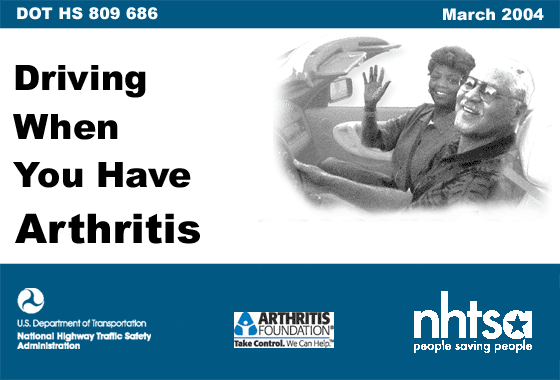Driving When You Have Arthritis
- For most people, driving represents freedom, control and independence. Driving enables most people to get to the places they want or need to go. For many people, driving is important economically – some drive as part of their job or to get to and from work.
- Driving is a complex skill. Our ability to drive safely can be affected by changes in our physical, emotional and mental condition.
- The goal of this brochure is to help you, your family and your health care professional talk about how arthritis may affect your ability to drive safely.
How can arthritis affect my driving?
- Having arthritis can make your joints swollen and stiff, which can limit how far you can bend or move your shoulders, hands, head and neck. This can make it harder to grasp or turn the steering wheel, apply the brake and gas pedals, put on your safety belt or look over your shoulder to check your blind spot.
- As a result, arthritis can make it harder for you to drive safely. If arthritis affects your hips, knees, ankles or feet, you also may have difficulty getting in and out of your car.
Can I still drive with arthritis?
- Yes, most people can drive safely with arthritis. It depends on which joints are affected, and how well you and your doctor are able to manage your condition. Your doctor cares about your health and safety, and will work with you and your loved ones to manage your care.
- If you use medicine to treat your arthritis, make sure it doesn't make you sleepy. Ask your doctor about other treatments that can help with your pain, swelling, and soreness – treatments that will not make it difficult to drive safely.
- Arthritis can limit your movement and strength, so try to stay fit and active. Doing so will help you to keep driving safely. Ask your doctor about exercises to keep your joints strong and supple.
What can I do when arthritis affects my driving?
- Your doctor can refer you to a rehabilitation center or a specialist who can determine if, and how, your arthritis is affecting your driving. The specialist may offer training to improve your driving skills. That training may include how to use special devices that you can have installed in your car to make it easier for you to drive safely. You will need training on the use of those devices, however, before beginning to drive with them.
- Improving your driving skills could help keep you and others around you safe. To find a driver rehabilitation specialist near you, go to www.aota.org/olderdriver and look up the name of a specialist in your state. You also can call hospitals and rehabilitation facilities to find an occupational therapist who can help with the driving skills assessment, remediation and with choosing and using the special devices to make it easier for you to drive with arthritis. Depending on where you live, you may need to travel to nearby communities to find these services.
What if I have to cut back or give up driving?
- You can keep your independence even if you have to cut back or give up on your driving. It may take planning ahead on your part, but it will get you to the places you want to go and the people you want to see. Consider:
- rides with family and friends;
- taxi cabs;
- shuttle buses or vans;
- public buses, trains and subways; and
- walking.
- rides with family and friends;
- Also, senior centers, and religious and other local service groups often offer transportation services for older adults in your community.
Who can I call for help with transportation?
Call the ElderCare Locator at 1-800-677-1116 and ask for the phone number of your local Office on Aging, or go to their website at www.eldercare.gov.
Contact your regional transit authority to find out which bus or train to take.
Call Easter Seals Project ACTION (Accessible Community Transportation In Our Nation) at 1-800-659-6428 or go to their website at www.easterseals.com/transportation.
Where do I find out more about arthritis?
Your first step is to talk with your health care professional. You also can contact the:
Arthritis Foundation 1-800-283-7800
www.arthritis.org
American Academy of Orthopaedic Surgeons
1-800-346-AAOS (1-800-346-2267)
www.aaos.org
National Institute of Arthritis and Musculoskeletal and Skin Diseases Information Clearinghouse 1-877-226-4267 www.niams.nih.gov
You also can get a copy of the “Age Page On Older Drivers” from the National Institute on Aging by calling
1-800-222-2225, or by going to their website at www.niapublications.org/engagepages/drivers.asp.
Wear your safety belt
Always wear your safety belt when you are driving or riding in a car. If arthritis makes it difficult for you to use your safety belt, speak with a driving specialist who can often help you find devices to make buckling up much easier. Make sure that every person who is riding with you also is buckled up. Wear your safety belt even if your car has air bags.
